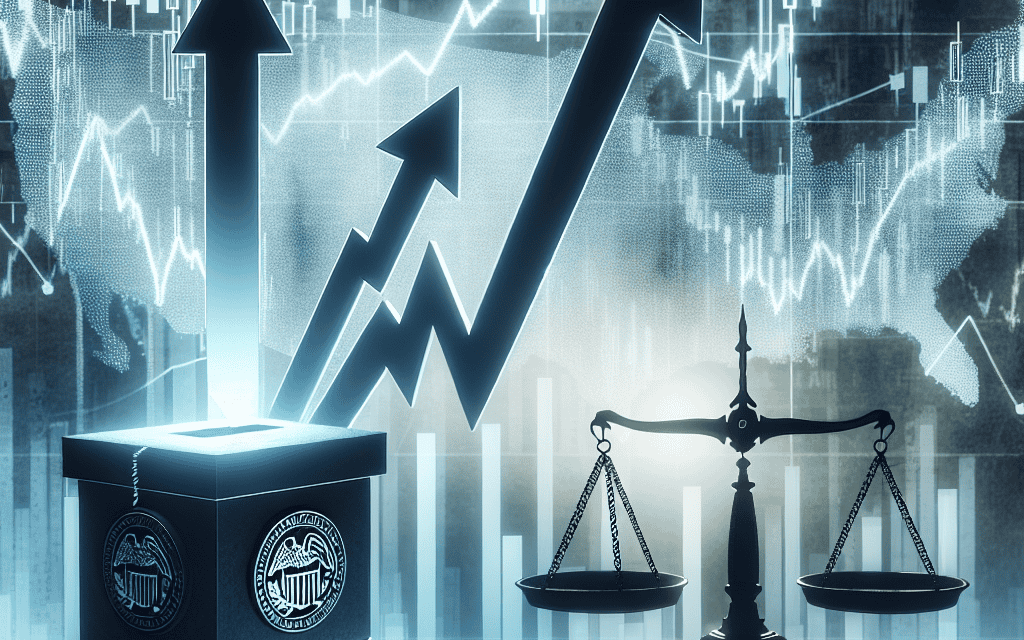“Navigating Uncertainty: Markets on Edge as Elections and Fed Decisions Loom”
Introduction
Market tensions are escalating as investors grapple with the dual uncertainties of an impending election and the Federal Reserve’s monetary policy direction. As political campaigns intensify, the potential for significant shifts in economic policy looms large, prompting market participants to reassess risk and recalibrate their strategies. Concurrently, the Federal Reserve’s stance on interest rates and inflation remains a focal point, with any signals of policy adjustments likely to reverberate through financial markets. This confluence of political and economic uncertainty is creating a volatile environment, challenging investors to navigate the complexities of a rapidly evolving landscape.
Impact Of Election Uncertainty On Global Markets
As the world watches the unfolding political landscape in the United States, the global markets are experiencing heightened volatility, driven by the dual forces of election uncertainty and the Federal Reserve’s monetary policy decisions. Investors, analysts, and policymakers alike are grappling with the implications of these developments, which have far-reaching consequences for financial markets worldwide. The uncertainty surrounding the upcoming election has created a climate of apprehension, as market participants attempt to anticipate the potential outcomes and their subsequent impact on economic policies. Historically, elections have been periods of increased market volatility, as investors adjust their portfolios in response to the perceived risks and opportunities associated with different political scenarios. This year, the stakes are particularly high, given the polarized political environment and the significant policy differences between the candidates.
In addition to the election-related uncertainties, the Federal Reserve’s monetary policy stance is another critical factor influencing market dynamics. The Fed’s decisions on interest rates and other monetary measures are closely watched by global investors, as they have a direct impact on asset prices, currency valuations, and capital flows. With inflationary pressures persisting and economic growth showing signs of slowing, the Fed faces a delicate balancing act in its efforts to maintain price stability while supporting economic recovery. The interplay between these two sources of uncertainty—election outcomes and Fed policy—has created a complex environment for market participants. On one hand, the prospect of a change in administration could lead to shifts in fiscal policy, regulatory frameworks, and international trade relations, all of which have significant implications for global markets. On the other hand, the Fed’s actions, or lack thereof, could either exacerbate or mitigate the market’s response to these political developments.
Moreover, the interconnectedness of global financial markets means that the ripple effects of U.S. political and monetary policy decisions are felt far beyond its borders. Emerging markets, in particular, are vulnerable to shifts in investor sentiment and capital flows, as changes in U.S. interest rates can lead to currency fluctuations and affect the cost of borrowing. Consequently, countries with high levels of foreign debt or those reliant on external financing may find themselves under increased pressure in the face of rising market tensions. In this context, it is crucial for investors to adopt a cautious approach, carefully assessing the potential risks and opportunities presented by the current environment. Diversification, risk management, and a focus on long-term fundamentals are essential strategies for navigating the uncertainties that lie ahead. Additionally, staying informed about the latest developments in both the political and economic spheres can help investors make more informed decisions.
In conclusion, the current period of market tension, driven by election uncertainty and Fed policy, underscores the importance of vigilance and adaptability in the face of rapidly changing conditions. As the election approaches and the Fed continues to navigate its policy path, market participants must remain attuned to the evolving landscape and be prepared to adjust their strategies accordingly. While the road ahead may be fraught with challenges, it also presents opportunities for those who are able to navigate the complexities of this dynamic environment with foresight and resilience.
How Federal Reserve Decisions Influence Market Volatility
Market tensions are on the rise as the dual uncertainties of an impending election and Federal Reserve decisions loom large over the financial landscape. Investors, analysts, and policymakers alike are closely monitoring these developments, as they have the potential to significantly influence market volatility. The Federal Reserve, as the central bank of the United States, plays a pivotal role in shaping economic conditions through its monetary policy decisions. These decisions, in turn, have a profound impact on market behavior, often leading to heightened volatility during periods of uncertainty.
To understand how Federal Reserve decisions influence market volatility, it is essential to consider the mechanisms through which monetary policy affects the economy. The Federal Reserve primarily uses tools such as interest rate adjustments, open market operations, and forward guidance to manage economic growth and inflation. When the Fed raises or lowers interest rates, it directly affects borrowing costs for consumers and businesses, thereby influencing spending and investment decisions. For instance, a rate hike typically leads to higher borrowing costs, which can dampen economic activity and, consequently, impact stock and bond markets.
Moreover, the Federal Reserve’s communication strategy, often referred to as forward guidance, plays a crucial role in shaping market expectations. By signaling its future policy intentions, the Fed can influence investor sentiment and market behavior. However, during times of uncertainty, such as an election period, the effectiveness of forward guidance can be challenged. Investors may become more sensitive to any perceived changes in the Fed’s stance, leading to increased market volatility. This is particularly true when there is a lack of clarity regarding the future direction of monetary policy.
In addition to interest rate decisions and forward guidance, the Federal Reserve’s balance sheet operations also have significant implications for market volatility. Through quantitative easing or tightening, the Fed can influence the supply of money in the economy, thereby affecting asset prices. For example, during periods of quantitative easing, the Fed purchases government securities, which can lead to lower yields and higher asset prices. Conversely, when the Fed unwinds its balance sheet, it can lead to upward pressure on yields and increased market volatility.
The interplay between Federal Reserve decisions and market volatility becomes even more pronounced during election periods. Elections introduce an additional layer of uncertainty, as changes in political leadership can lead to shifts in fiscal policy, regulatory frameworks, and international relations. Investors often grapple with the potential implications of these changes, leading to increased market sensitivity to Fed announcements. In such an environment, even minor adjustments in the Fed’s policy stance can trigger significant market reactions.
Furthermore, the global interconnectedness of financial markets means that Federal Reserve decisions can have ripple effects beyond U.S. borders. As the world’s largest economy, U.S. monetary policy decisions can influence global capital flows, exchange rates, and economic conditions in other countries. This interconnectedness amplifies the impact of Fed decisions on market volatility, as investors worldwide adjust their portfolios in response to changes in U.S. monetary policy.
In conclusion, Federal Reserve decisions are a critical factor influencing market volatility, particularly during periods of heightened uncertainty such as elections. Through interest rate adjustments, forward guidance, and balance sheet operations, the Fed shapes economic conditions and investor expectations. As market participants navigate the complexities of election and Fed uncertainty, understanding the intricate relationship between monetary policy and market behavior becomes increasingly important. This knowledge enables investors to make informed decisions and better manage the risks associated with market volatility.
Strategies For Investors During Political And Economic Uncertainty
In times of political and economic uncertainty, such as those currently experienced due to election tensions and Federal Reserve unpredictability, investors often find themselves navigating a complex landscape. The interplay between political events and economic policy can create volatility in financial markets, prompting investors to reassess their strategies. Understanding how to manage investments during such periods is crucial for maintaining financial stability and achieving long-term goals.
Firstly, diversification remains a cornerstone strategy for investors facing uncertainty. By spreading investments across various asset classes, sectors, and geographic regions, investors can mitigate risks associated with market volatility. This approach helps cushion portfolios against adverse movements in any single market segment. For instance, while equities might experience fluctuations due to political developments, bonds or commodities might offer more stability. Therefore, maintaining a well-diversified portfolio can provide a buffer against unforeseen market shifts.
Moreover, focusing on quality investments is essential during uncertain times. Companies with strong balance sheets, consistent cash flow, and a history of weathering economic downturns are often better positioned to withstand market turbulence. These firms tend to have the resilience needed to navigate periods of uncertainty, making them attractive options for investors seeking stability. Additionally, sectors that are less sensitive to political changes, such as consumer staples and healthcare, can offer more predictable returns, providing a safe haven for cautious investors.
In addition to diversification and quality, maintaining a long-term perspective is vital. Market volatility can tempt investors to make impulsive decisions based on short-term fluctuations. However, history has shown that markets tend to recover over time, rewarding those who remain patient and committed to their investment strategies. By focusing on long-term goals and avoiding reactionary moves, investors can better withstand the emotional rollercoaster that often accompanies political and economic uncertainty.
Furthermore, staying informed is crucial for making sound investment decisions. Keeping abreast of political developments, economic indicators, and central bank policies can provide valuable insights into potential market movements. Investors should pay close attention to statements from the Federal Reserve, as changes in interest rates or monetary policy can significantly impact market dynamics. By understanding the broader economic context, investors can make more informed decisions and adjust their strategies accordingly.
Additionally, maintaining liquidity is a prudent strategy during uncertain times. Having a portion of the portfolio in cash or cash-equivalent assets provides flexibility to capitalize on opportunities that may arise from market dislocations. This liquidity can also serve as a safety net, allowing investors to meet short-term financial needs without having to sell long-term investments at a loss.
Finally, consulting with financial advisors can offer valuable guidance during periods of uncertainty. Advisors can provide personalized strategies tailored to individual risk tolerances and financial goals, helping investors navigate the complexities of the market. Their expertise can be particularly beneficial in assessing the potential impacts of political and economic developments on investment portfolios.
In conclusion, while political and economic uncertainty can pose challenges for investors, adopting a strategic approach can help mitigate risks and capitalize on opportunities. By diversifying portfolios, focusing on quality investments, maintaining a long-term perspective, staying informed, ensuring liquidity, and seeking professional advice, investors can navigate these turbulent times with greater confidence. As market tensions rise amid election and Fed uncertainty, these strategies offer a roadmap for achieving financial resilience and success.
Historical Analysis Of Market Reactions To Election Years

Throughout history, financial markets have exhibited a tendency to react with heightened sensitivity during election years, a phenomenon that can be attributed to the uncertainty surrounding potential policy changes and their implications for economic conditions. As investors grapple with the unpredictability of electoral outcomes, market volatility often intensifies, reflecting the collective anxiety of stakeholders who are keenly aware of the stakes involved. This pattern of market behavior is not a recent development; rather, it has been observed consistently over the decades, providing a rich tapestry of data for analysts seeking to understand the interplay between political events and market dynamics.
In examining historical market reactions to election years, it becomes evident that the anticipation of policy shifts can lead to significant fluctuations in stock prices. For instance, during the 2008 U.S. presidential election, the financial crisis was already in full swing, and the markets were on edge as investors awaited the new administration’s approach to economic recovery. The uncertainty surrounding the election contributed to increased volatility, with the S&P 500 experiencing notable swings in the months leading up to and following the election. Similarly, the 2016 election saw markets initially react negatively to the unexpected outcome, only to rebound as investors recalibrated their expectations based on the anticipated policy directions of the incoming administration.
Moreover, the role of the Federal Reserve during election years cannot be understated. The Fed’s monetary policy decisions are closely scrutinized, as they have the potential to either exacerbate or mitigate market tensions. Historically, the Fed has often opted for a cautious approach during election years, aiming to maintain stability and avoid any perception of political influence. However, this does not always assuage market concerns, as investors remain vigilant for any signs of shifts in monetary policy that could impact interest rates and, consequently, market valuations.
The interplay between election-related uncertainty and Fed policy is further complicated by the broader economic context in which these events occur. For example, during the 2000 election, the dot-com bubble was a significant factor influencing market behavior. The uncertainty surrounding the election outcome, coupled with the bursting of the bubble, led to a period of pronounced market volatility. In contrast, the 2012 election took place against the backdrop of a slow but steady economic recovery from the Great Recession, which helped to temper market reactions despite the inherent uncertainties of the electoral process.
As we consider the current landscape, it is clear that the confluence of election-related uncertainty and potential shifts in Fed policy continues to be a source of tension for markets. Investors are acutely aware of the implications that electoral outcomes can have on fiscal policy, regulatory environments, and international relations, all of which can significantly impact market performance. At the same time, the Fed’s actions remain a critical focal point, as any adjustments to interest rates or other monetary policy tools can have far-reaching effects on economic conditions and investor sentiment.
In conclusion, the historical analysis of market reactions to election years underscores the complex interplay between political events and financial markets. While each election year presents its own unique set of circumstances, the underlying themes of uncertainty and anticipation remain constant. As investors navigate these turbulent waters, they must remain attuned to both the political landscape and the actions of the Federal Reserve, recognizing that these factors are inextricably linked in shaping market outcomes.
The Role Of Media In Shaping Market Perceptions During Elections
In the intricate dance of market dynamics, the role of media becomes particularly pronounced during election periods, when uncertainty looms large and investor sentiment is on edge. As the nation braces for the upcoming elections, the media’s influence in shaping market perceptions cannot be overstated. The interplay between media narratives and market reactions is a complex one, where the dissemination of information, whether factual or speculative, can significantly sway investor behavior and market outcomes.
During election cycles, media outlets are tasked with the responsibility of providing timely and accurate information. However, the challenge lies in balancing this responsibility with the inherent biases and editorial slants that may color reporting. As investors seek clarity amidst the cacophony of election-related news, the media’s portrayal of candidates’ economic policies, potential regulatory changes, and geopolitical stances becomes a critical factor in shaping market perceptions. For instance, a candidate’s proposed tax reforms or trade policies can lead to market volatility as investors attempt to anticipate the potential impact on various sectors.
Moreover, the media’s role extends beyond mere reporting; it also involves interpreting and analyzing the implications of political developments. This analysis often influences investor sentiment, as media outlets provide expert opinions and forecasts that can either assuage or exacerbate market fears. In this context, the media serves as both a mirror and a magnifier of market anxieties, reflecting existing concerns while also amplifying them through continuous coverage and commentary.
In addition to election-related uncertainties, the Federal Reserve’s monetary policy decisions add another layer of complexity to market perceptions. The media’s coverage of the Fed’s actions, statements, and minutes from meetings plays a pivotal role in shaping expectations around interest rates and economic stability. As the Fed navigates the delicate balance between curbing inflation and supporting economic growth, media narratives can influence how these decisions are perceived by the market. For example, a media focus on potential rate hikes may lead to increased market volatility as investors adjust their portfolios in anticipation of tighter monetary conditions.
The symbiotic relationship between media and markets is further complicated by the rise of digital platforms and social media, which have democratized information dissemination but also contributed to the spread of misinformation. In an era where news travels at lightning speed, the challenge for investors is to discern credible information from noise. The media’s role in providing context and clarity becomes even more crucial, as market participants rely on trusted sources to navigate the turbulent waters of election and Fed-related uncertainties.
In conclusion, the media’s influence on market perceptions during election periods is multifaceted and profound. As investors grapple with the dual uncertainties of electoral outcomes and Federal Reserve policies, the media serves as both a guide and a gatekeeper, shaping narratives that can either stabilize or destabilize market sentiment. The responsibility of media outlets to provide accurate, balanced, and insightful coverage is paramount, as their reporting can have far-reaching implications for market dynamics. As such, the media’s role in shaping market perceptions is not only about informing the public but also about fostering a deeper understanding of the complex interplay between politics, policy, and economic realities.
Comparing Market Responses To Different Election Outcomes
As the political landscape in the United States becomes increasingly charged with the approach of a major election, market participants are closely monitoring the potential outcomes and their implications for economic policy. Historically, markets have demonstrated varied responses to different election results, reflecting the anticipated shifts in fiscal and regulatory policies that accompany changes in administration. This year, the stakes are particularly high, as the election coincides with significant uncertainty surrounding the Federal Reserve’s monetary policy direction. Consequently, investors are keenly aware of the dual impact that election outcomes and Fed decisions could have on market stability and economic growth.
In examining past election cycles, it becomes evident that markets tend to react favorably to outcomes that promise continuity and predictability. For instance, when an incumbent party retains control, there is often a sense of stability that reassures investors, leading to positive market movements. Conversely, a change in administration can introduce a degree of uncertainty, as new policies and priorities are anticipated. This uncertainty can result in market volatility, as investors adjust their portfolios to align with the expected policy shifts. However, it is important to note that the initial market reaction is not always indicative of long-term trends, as markets eventually adapt to new political realities.
The current election cycle is further complicated by the Federal Reserve’s ongoing deliberations over interest rates and monetary policy. With inflationary pressures persisting and economic growth showing signs of slowing, the Fed faces a delicate balancing act. Market participants are particularly sensitive to any signals from the Fed regarding potential rate hikes or shifts in its quantitative easing program. The interplay between election outcomes and Fed policy is crucial, as the two can either complement or counteract each other in shaping economic conditions.
For example, a market-friendly election outcome that aligns with the Fed’s policy stance could bolster investor confidence and support economic expansion. On the other hand, a scenario where election results lead to policy uncertainty, coupled with a hawkish Fed, could exacerbate market tensions and hinder growth prospects. Therefore, investors are closely analyzing the potential policy platforms of candidates and their implications for sectors such as healthcare, energy, and technology, which are particularly sensitive to regulatory changes.
Moreover, the global economic environment adds another layer of complexity to the situation. With geopolitical tensions and supply chain disruptions continuing to pose challenges, the interconnectedness of global markets means that domestic election outcomes can have far-reaching effects. Investors are increasingly aware of the need to consider international factors when assessing the potential impact of U.S. elections on their portfolios.
In conclusion, as market tensions rise amid election and Fed uncertainty, investors are navigating a complex landscape characterized by potential policy shifts and economic challenges. By examining historical market responses to different election outcomes, it becomes clear that while initial reactions may vary, markets ultimately adapt to new political and economic realities. The interplay between election results and Federal Reserve policy will be pivotal in shaping market dynamics in the coming months. As such, investors are advised to remain vigilant and adaptable, considering both domestic and global factors in their decision-making processes.
The Interplay Between Monetary Policy And Market Sentiment
In recent months, the financial markets have been gripped by a palpable sense of uncertainty, driven by the dual forces of an impending election and the Federal Reserve’s monetary policy decisions. This confluence of political and economic factors has created a complex landscape where market sentiment is increasingly volatile. Investors are keenly aware that the outcomes of these events could significantly influence the trajectory of the economy, prompting a cautious approach to investment strategies.
The Federal Reserve, as the central bank of the United States, plays a pivotal role in shaping economic conditions through its monetary policy. Its decisions on interest rates and other financial instruments are closely monitored by market participants, as they have far-reaching implications for economic growth, inflation, and employment. In times of uncertainty, the Fed’s actions are scrutinized even more intensely, as investors seek clues about the future direction of the economy. Currently, the Fed faces the delicate task of balancing the need to curb inflationary pressures with the desire to support economic growth. This balancing act is further complicated by the political climate, as the upcoming election introduces additional variables that could impact fiscal policy and regulatory frameworks.
As the election approaches, market participants are acutely aware that political outcomes can lead to shifts in economic policy. Different administrations may prioritize varying economic agendas, influencing everything from tax policy to government spending. Consequently, investors are attempting to anticipate these potential changes and adjust their portfolios accordingly. However, the inherent unpredictability of electoral outcomes adds a layer of complexity to this task. The interplay between political developments and market sentiment is evident, as investors react to polling data, campaign rhetoric, and policy proposals. This dynamic creates a feedback loop where market movements can, in turn, influence political discourse, further amplifying uncertainty.
In this environment, market sentiment becomes a critical factor in driving asset prices. Investor confidence, or lack thereof, can lead to significant fluctuations in stock prices, bond yields, and currency values. The psychological aspect of investing is magnified during periods of uncertainty, as fear and optimism can lead to exaggerated market reactions. For instance, a hawkish stance from the Fed might be interpreted as a signal of confidence in the economy’s resilience, boosting investor sentiment. Conversely, dovish signals could be perceived as a response to underlying economic weaknesses, prompting caution among investors.
To navigate these turbulent waters, market participants are increasingly relying on a combination of fundamental analysis and sentiment indicators. By examining economic data, corporate earnings, and geopolitical developments, investors aim to construct a comprehensive view of the market landscape. At the same time, sentiment indicators, such as the VIX index, provide insights into the prevailing mood of the market, offering clues about potential volatility.
In conclusion, the interplay between monetary policy and market sentiment is a complex and dynamic process, particularly in the context of election-related uncertainties. As the Federal Reserve and political actors continue to shape the economic environment, investors must remain vigilant and adaptable. By understanding the intricate relationships between these factors, market participants can better position themselves to navigate the challenges and opportunities that lie ahead. As the situation evolves, the ability to interpret and respond to these signals will be crucial in achieving investment success amidst rising market tensions.
Q&A
1. **What are the main factors contributing to market tensions?**
– Market tensions are primarily driven by uncertainties surrounding upcoming elections and the Federal Reserve’s monetary policy decisions.
2. **How do elections impact market stability?**
– Elections can lead to market instability due to potential policy changes, shifts in regulatory environments, and investor uncertainty about future economic directions.
3. **What role does the Federal Reserve play in market tensions?**
– The Federal Reserve influences market tensions through its interest rate policies and monetary policy signals, which affect borrowing costs, inflation expectations, and overall economic confidence.
4. **How do investors typically react to election-related uncertainties?**
– Investors may adopt a cautious approach, reducing risk exposure, diversifying portfolios, or seeking safe-haven assets to mitigate potential volatility.
5. **What are some potential outcomes of Fed policy uncertainty?**
– Uncertainty about Fed policy can lead to increased market volatility, fluctuations in bond yields, and shifts in currency values as investors speculate on future interest rate changes.
6. **How might market tensions affect consumer confidence?**
– Market tensions can erode consumer confidence if they lead to economic instability, job market concerns, or reduced investment in businesses, impacting spending and economic growth.
7. **What strategies can investors use to navigate market tensions?**
– Investors might focus on diversification, hedging strategies, maintaining liquidity, and staying informed about economic indicators and policy developments to manage risks during periods of market tension.
Conclusion
Market tensions are escalating due to the dual uncertainties surrounding upcoming elections and the Federal Reserve’s monetary policy decisions. Investors are grappling with potential shifts in economic policy and regulatory changes that could arise from the election outcomes, while also trying to anticipate the Fed’s response to inflationary pressures and economic growth. This confluence of political and economic uncertainty is contributing to increased market volatility, as stakeholders seek to navigate the potential impacts on financial markets and the broader economy. As a result, market participants are likely to remain cautious, with a focus on risk management and strategic positioning until greater clarity emerges.





